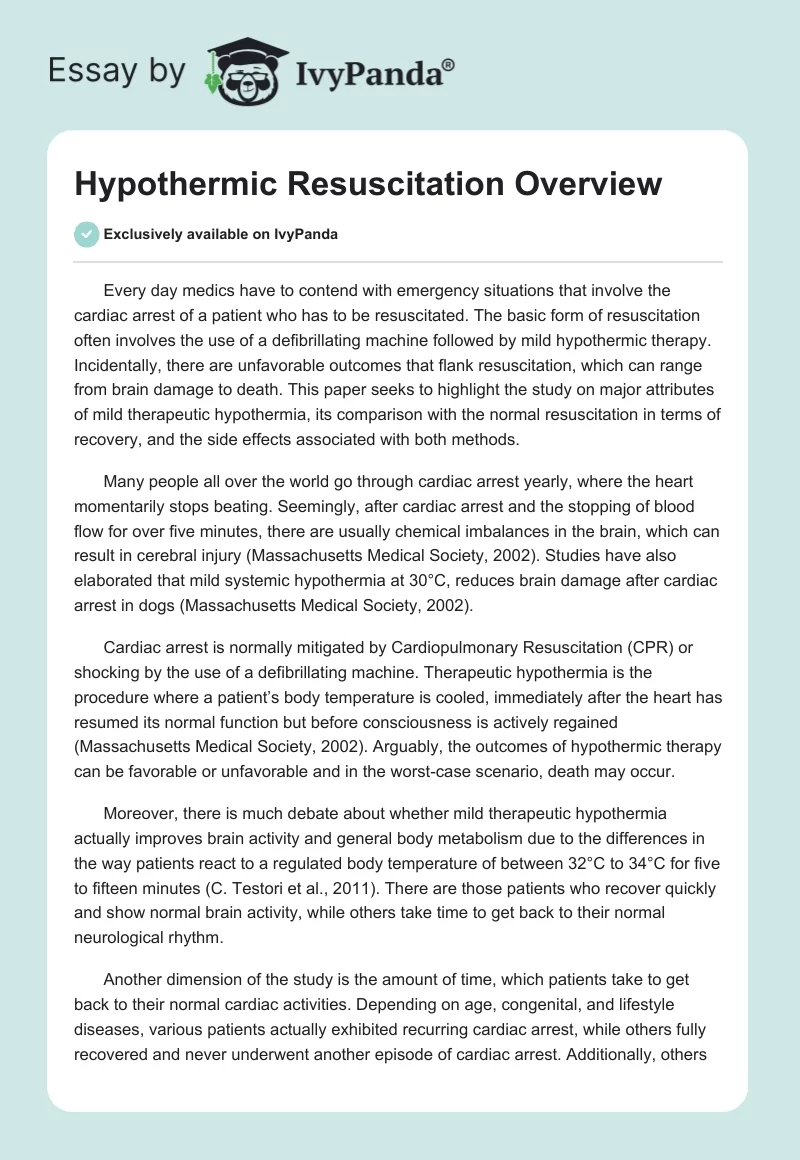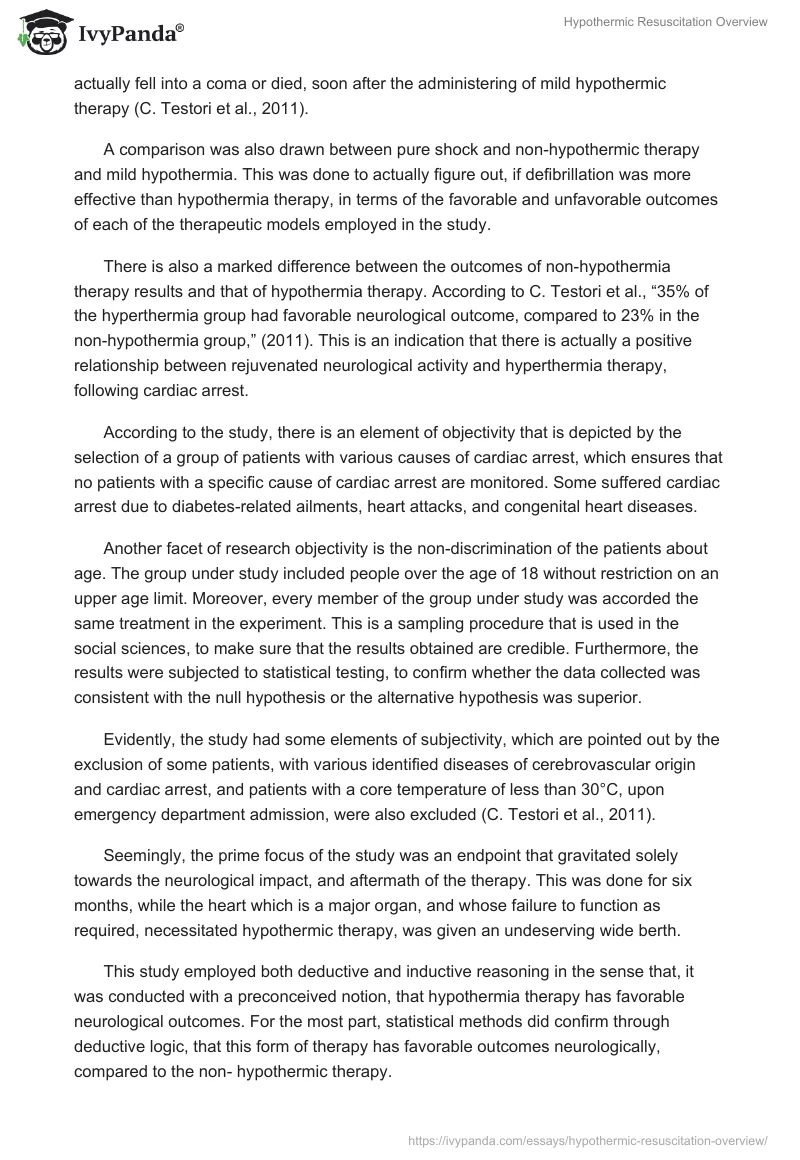Every day medics have to contend with emergency situations that involve the cardiac arrest of a patient who has to be resuscitated. The basic form of resuscitation often involves the use of a defibrillating machine followed by mild hypothermic therapy. Incidentally, there are unfavorable outcomes that flank resuscitation, which can range from brain damage to death. This paper seeks to highlight the study on major attributes of mild therapeutic hypothermia, its comparison with the normal resuscitation in terms of recovery, and the side effects associated with both methods.
Many people all over the world go through cardiac arrest yearly, where the heart momentarily stops beating. Seemingly, after cardiac arrest and the stopping of blood flow for over five minutes, there are usually chemical imbalances in the brain, which can result in cerebral injury (Massachusetts Medical Society, 2002). Studies have also elaborated that mild systemic hypothermia at 30°C, reduces brain damage after cardiac arrest in dogs (Massachusetts Medical Society, 2002).
Cardiac arrest is normally mitigated by Cardiopulmonary Resuscitation (CPR) or shocking by the use of a defibrillating machine. Therapeutic hypothermia is the procedure where a patient’s body temperature is cooled, immediately after the heart has resumed its normal function but before consciousness is actively regained (Massachusetts Medical Society, 2002). Arguably, the outcomes of hypothermic therapy can be favorable or unfavorable and in the worst-case scenario, death may occur.
Moreover, there is much debate about whether mild therapeutic hypothermia actually improves brain activity and general body metabolism due to the differences in the way patients react to a regulated body temperature of between 32°C to 34°C for five to fifteen minutes (C. Testori et al., 2011). There are those patients who recover quickly and show normal brain activity, while others take time to get back to their normal neurological rhythm.
Another dimension of the study is the amount of time, which patients take to get back to their normal cardiac activities. Depending on age, congenital, and lifestyle diseases, various patients actually exhibited recurring cardiac arrest, while others fully recovered and never underwent another episode of cardiac arrest. Additionally, others actually fell into a coma or died, soon after the administering of mild hypothermic therapy (C. Testori et al., 2011).
A comparison was also drawn between pure shock and non-hypothermic therapy and mild hypothermia. This was done to actually figure out, if defibrillation was more effective than hypothermia therapy, in terms of the favorable and unfavorable outcomes of each of the therapeutic models employed in the study.
There is also a marked difference between the outcomes of non-hypothermia therapy results and that of hypothermia therapy. According to C. Testori et al., “35% of the hyperthermia group had favorable neurological outcome, compared to 23% in the non-hypothermia group,” (2011). This is an indication that there is actually a positive relationship between rejuvenated neurological activity and hyperthermia therapy, following cardiac arrest.
According to the study, there is an element of objectivity that is depicted by the selection of a group of patients with various causes of cardiac arrest, which ensures that no patients with a specific cause of cardiac arrest are monitored. Some suffered cardiac arrest due to diabetes-related ailments, heart attacks, and congenital heart diseases.
Another facet of research objectivity is the non-discrimination of the patients about age. The group under study included people over the age of 18 without restriction on an upper age limit. Moreover, every member of the group under study was accorded the same treatment in the experiment. This is a sampling procedure that is used in the social sciences, to make sure that the results obtained are credible. Furthermore, the results were subjected to statistical testing, to confirm whether the data collected was consistent with the null hypothesis or the alternative hypothesis was superior.
Evidently, the study had some elements of subjectivity, which are pointed out by the exclusion of some patients, with various identified diseases of cerebrovascular origin and cardiac arrest, and patients with a core temperature of less than 30°C, upon emergency department admission, were also excluded (C. Testori et al., 2011).
Seemingly, the prime focus of the study was an endpoint that gravitated solely towards the neurological impact, and aftermath of the therapy. This was done for six months, while the heart which is a major organ, and whose failure to function as required, necessitated hypothermic therapy, was given an undeserving wide berth.
This study employed both deductive and inductive reasoning in the sense that, it was conducted with a preconceived notion, that hypothermia therapy has favorable neurological outcomes. For the most part, statistical methods did confirm through deductive logic, that this form of therapy has favorable outcomes neurologically, compared to the non- hypothermic therapy.
Mild hypothermia therapy has been given cognizance in the medical arena, because of its potential to reduce brain damage following cardiac arrest. If carried out well after the heart resumes its normal activity, there is a great probability of patients waking up to sound mental health. Even though shock therapy does bring about resuscitation, it does not adequately address the problem of restoration of blood circulation to the brain. It is therefore imperative that doctors and paramedics make sure that, CPR is applied concurrently with mild hypothermic therapy, to protect the brain from neurological disturbance.
References
Massachusetts Medical Society. (2002). Mild Therapeutic Hypothermia to Improve the Neurologic Outcome after Cardiac Arrest. The New England Journal of Medicine. Web.
Testori, C., Sterz F., Behringer W., Haugk M., Uray T., Zeiner A., Janata A., Arrich J., Holzer M., & Losert H. (2011). Resuscitation: Mild Therapeutic Hypothermia is Associated with Favorable Outcome in Patients after Cardiac Arrest with Non-Shockable Rhythms. Vienna: Elsevier Ireland.


